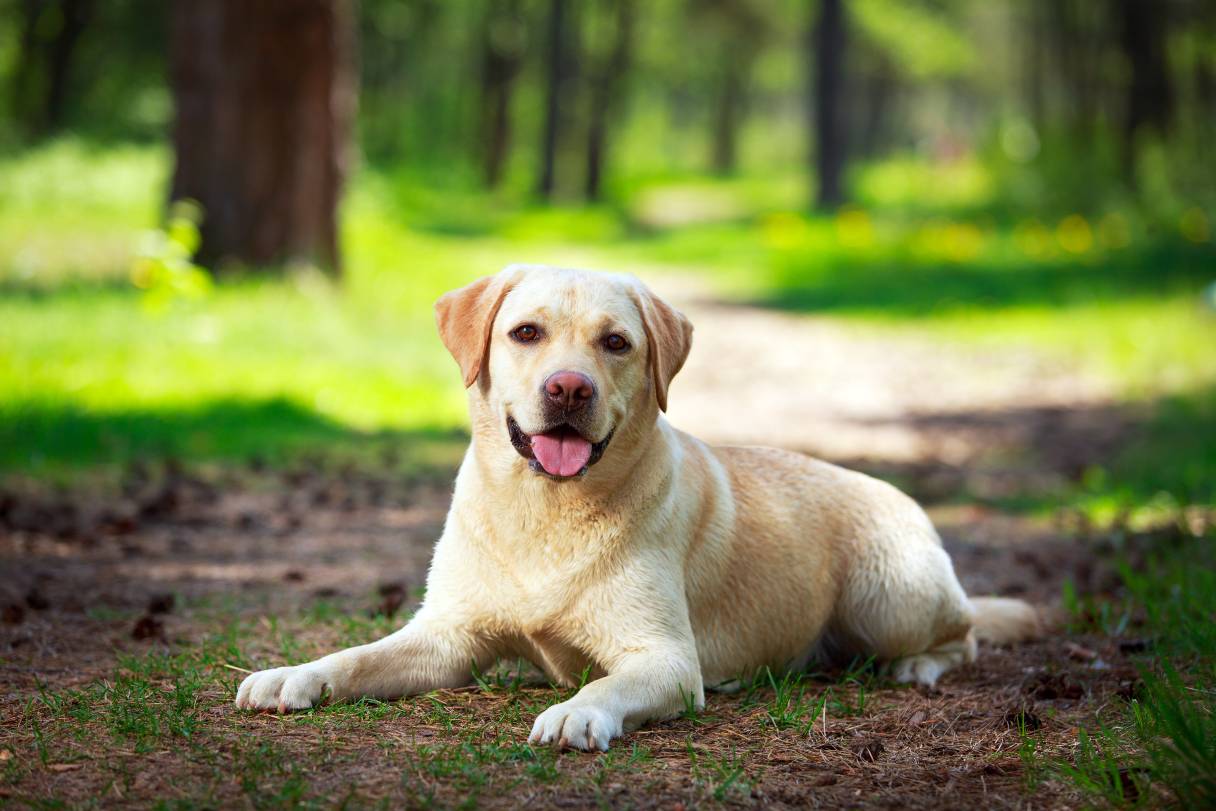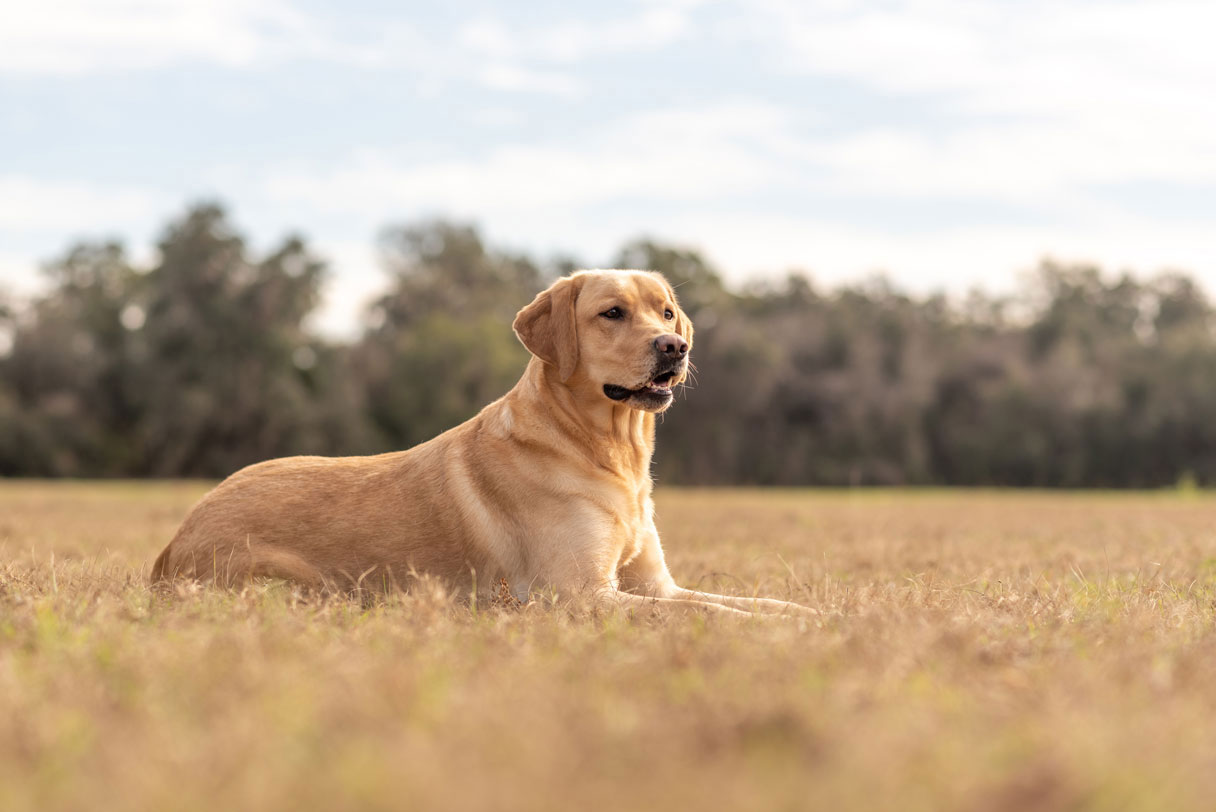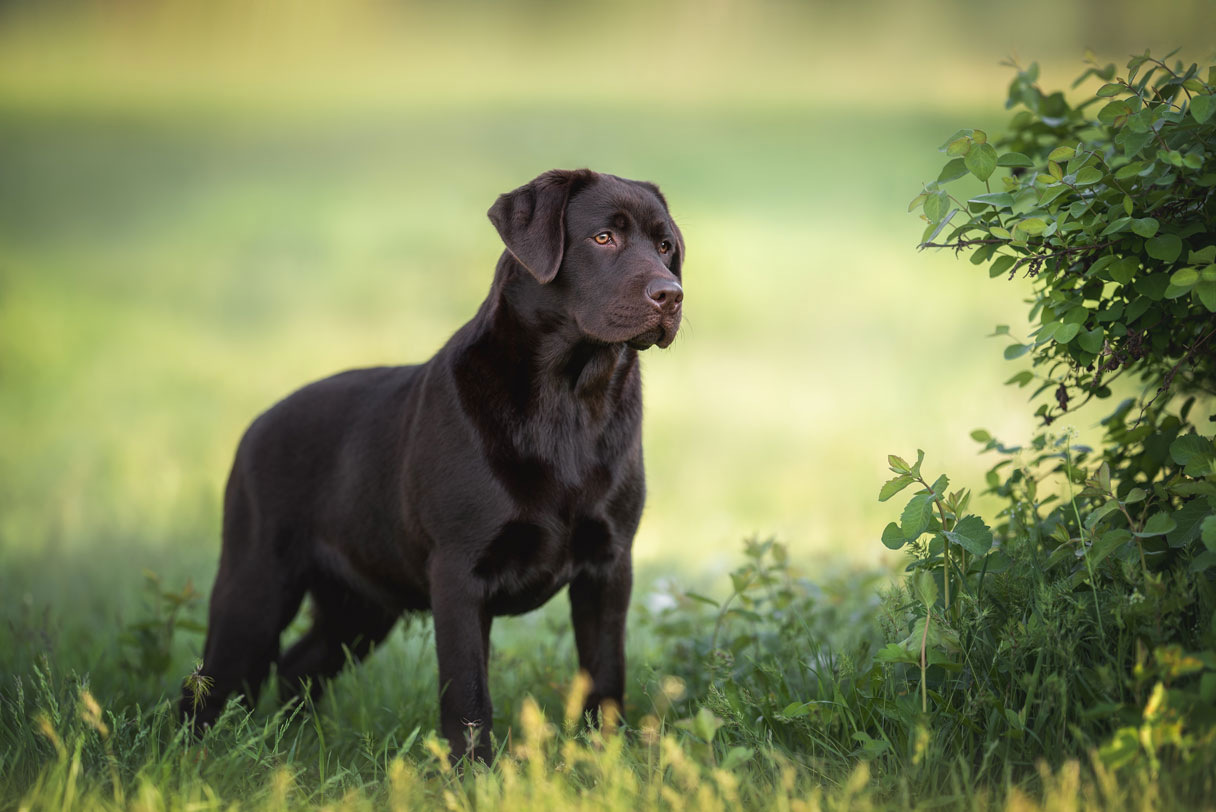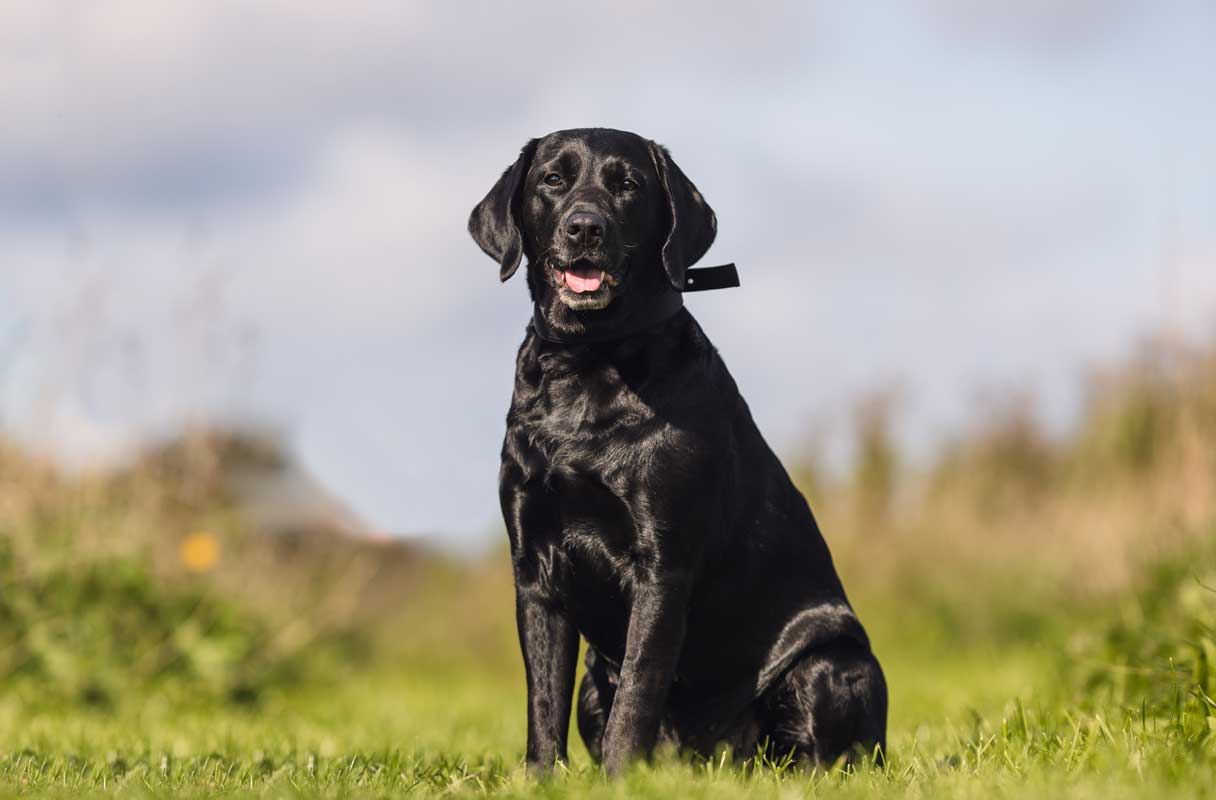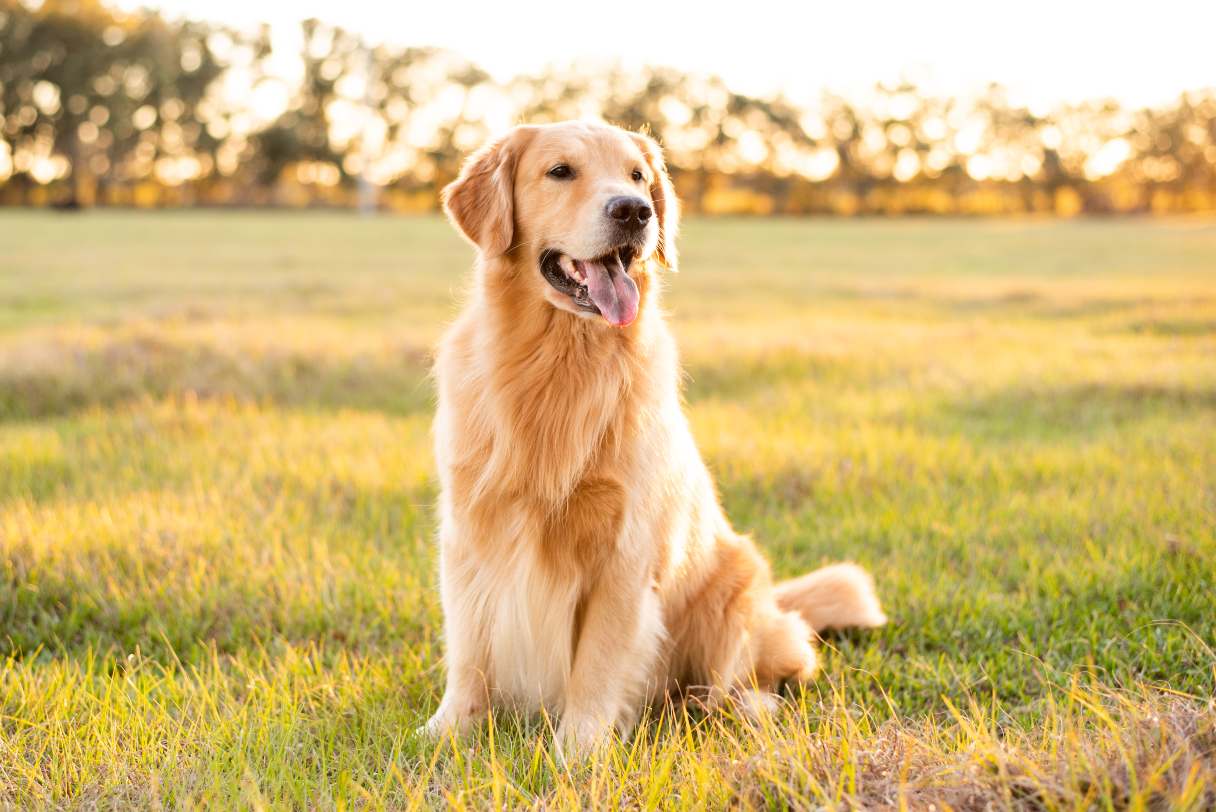If you’re looking for an enthusiastic adventure buddy who gets along with everyone and will love you more than life, a Labrador retriever — more commonly known as a Lab — may be your next furry bestie. Sweet, lovable, full of joy and zest for life, Labs are the quintessential family dog, bonding with everyone and always ready for the next family outing.1
Learn more about Labrador retrievers, their temperament and what’s involved in their daily care, as well as their health and wellness needs.
About the Labrador Retriever
Despite their name, this breed hails not from the Canadian province of Labrador but rather from the island of Newfoundland off its southeastern coast. How they came to be there, no one knows. But British gentry visiting the island in the 1800s were impressed by the hearty, obedient and friendly black water dogs that were employed in retrieving waterfowl and helping to collect fish off of fishing boats.2
English nobles brought some of these dogs back to England, where they set about breeding them for their hunting and retrieving abilities and their good temperament. The name of the breed can be credited to the Third Earl of Malmesbury, who wrote in a letter to the Sixth Duke of Buccleugh, “We always call mine Labrador dogs, and I have kept the breed as pure as I could from the first I had.”2
The Earl gave the Duke six of his Labrador dogs in 1870, and the Duke’s breeders kept the standard established by the Earl going.2 Labrador retrievers were first recognized as a special breed by the English Kennel Club in 1903.2 The American Kennel Club (AKC) registered its first Lab in 1917 and today counts it as one of their most enduringly popular breeds.1 To this day, most of the world’s Labs can be traced back to those six dogs that originally belonged to the Earl of Malmesbury.2
Labrador Retriever Appearance

Male Labs are large dogs, standing 22.5 to 24.5 inches at the shoulder and weighing in at 65 to 80 pounds. Females are medium to large, standing 21.5 to 23.5 inches tall and weighing 55 to 70 pounds.1
While some claim that there are stark differences between English and American Labs, this is debatable, as there is very little difference between the American3 and UK4 breed standards. That said, some breeders on both sides of the pond focus more on hunting and retrieving abilities and athleticism, while others concentrate on show conformation standards and temperament.5 These breeding focuses can result in slight differences in appearance and temperament; but at the end of the day, a Lab is a Lab.3
In general, Labs are deep-chested dogs with straight backs about as long from the shoulders to the rump as they are tall. One hallmark of the breed is its distinctive otter tail, which is thick at the base and tapers gradually down the length of the tail to the tip. Their tail is often in motion, whether propelling them through water or expressing their constant joy and enthusiasm.3
Labs have a large head with a wide skull that slopes down to a slightly pronounced brow that sits above a muzzle that’s just right — not short, nor excessively long or narrow, but proportionate to the rest of the head. The ears are also proportionate in size and hang down close to the face.3
The Lab’s short, straight and dense double coat is another distinguishing feature. The protective outer coat should feel dense and somewhat firm to the touch. It covers a soft, water-resistant undercoat. Labs come in three colors: yellow, chocolate and black. Yellow Labs may range in shading from red to light cream, and chocolates may vary from light to dark chocolate brown. Black Labs are all black but may have a small white patch on the chest.3
Labrador Retriever Temperament
Labs are extremely outgoing — way too much to make good guard dogs. But if you like to entertain, your Lab will be the life of the party. Incredibly loving, they form tight bonds with everyone in the family, including other pets. These dogs want to be where their people are and join in on the action.1
And they do love action. If not employed in hunting and retrieving, your Lab will enjoy going on adventures that include hiking, swimming and meeting new people, as well as endless hours of play. Although they’re friendly, they will bark to let you know someone is approaching and also just to say hi. But they won’t bark incessantly at every strange noise they hear.1
Labs are intelligent and eager to please, making them famously easy to train. But they do need training and socialization from a very young age to help them learn to check their enthusiasm and tone it down a notch or two.1
Living With a Labrador Retriever
As beloved as Labs are, their high energy levels mean they might not be the best dog for everyone. Here’s what you need to know about living with and caring for Labrador retrievers, including helpful tips for both current and prospective Lab parents.
Who they’re best for
Labs need a home where they can be an inside dog and be treated like part of the family. These are highly social dogs who dislike being left alone. If their people can’t be home with them most of the day, they’ll love another dog to keep them company.1
These are energetic dogs who love time outdoors and need someone who can take them on adventures and keep up with their substantial exercise and activity needs. This doesn’t necessarily mean you’ve got to lace up your hiking boots. Your Lab will be content with long walks around the neighborhood to say hi to the neighbors, car rides into town, romps at the dog park and endlessly retrieving tennis balls in the backyard.1
Living space
Labs are adaptable dogs who can get comfortable in a variety of living situations, as long as they can be with their family. Owners who don’t want to spend lots of time and energy going on frequent walks or hikes or toting their Lab to playdates at the park would do well to have a fenced backyard that’s large enough for running around and playing lots of fetch. The only thing Labs love more than fetching is swimming, so a backyard swimming pool would be a major bonus.1
Exercise and activity
Labs need a substantial amount of exercise and mental stimulation each day. Without it, they may become hyperactive and engage in destructive behavior as outlets for all that pent-up energy.1
These are sporty dogs who were made for the water. Swimming is their favorite activity and the quickest way to tire them out. They’re also natural retrievers, making fetch their favorite game to play. Warm up your throwing arm, because you’ll be playing a lot of it. Labs also love to go on walks, and they make the best companions for hiking and hunting trips. And they excel at pretty much all the canine sports.1
Grooming
The Lab’s water-repelling coat tends to stay clean, so they don’t need to be bathed much, but that coat does shed a lot.1 You’ll need to brush them regularly and get used to running the vacuum frequently. This probably isn’t the best breed for someone who’s allergic to dog hair.
Nails may need to be trimmed every few weeks or so. And brushing their teeth at least every few days will help keep their teeth and gums healthy between dental checkups.1
Labrador Retriever Health and Life Expectancy
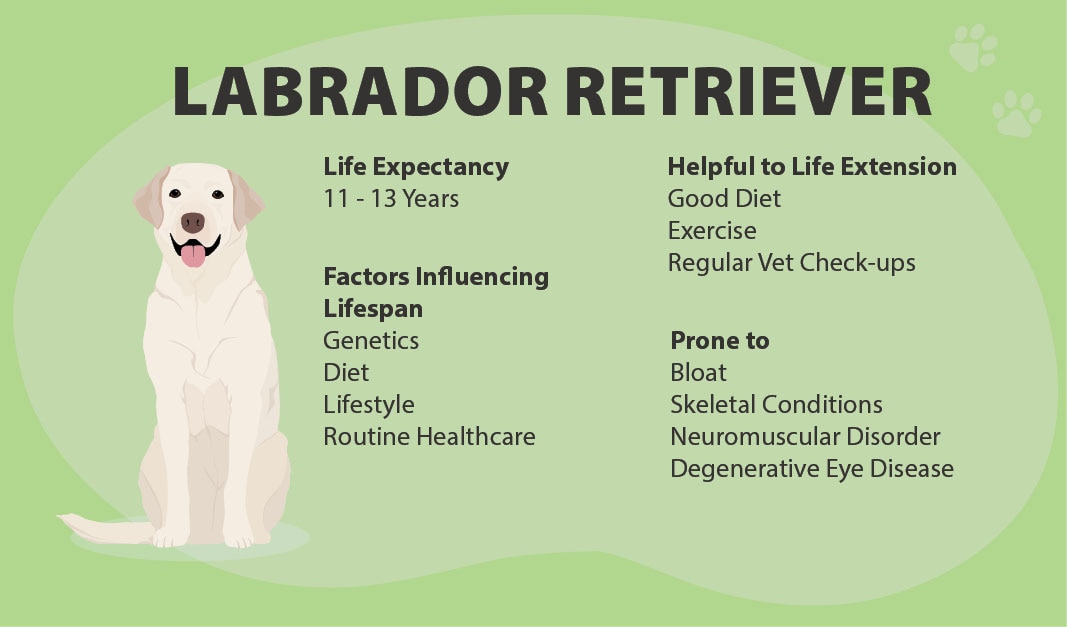
The average lifespan of a Labrador retriever is 11 to 13 years.1 But each dog is different, and factors such as genetics, diet, lifestyle and routine healthcare can make a difference in how long an individual dog lives. A good diet, plenty of exercise and being diligent with regular veterinary health checkups can go a long way toward helping your Lab live a long and happy life.
High-quality dog food that’s fitted to their current life stage is best.1 Look for food with a nutritional profile that’s been approved by the Association of American Feed Control Officials (AAFCO), and talk to your vet about the correct amount to maintain their ideal weight and avoid obesity.1 For best results, look for large-breed dog or puppy food, which contains nutrients that help support large and rapidly growing bones.6
The Lab is considered a healthy breed. Responsible breeders conduct genetic testing and health screenings to minimize hereditary health issues. But Labs may still face a few health issues that require veterinary care or ongoing management. Current and prospective Labrador retriever owners should be aware of these potential health issues:1
Hip and elbow dysplasia
As a large breed, Labs are at a higher risk for both elbow and hip dysplasia, in which the ball of a joint fits poorly into the socket. It’s a painful condition that can lead to osteoarthritis if it’s not treated. Mild cases may be managed with nutrition and lifestyle adjustments, while more severe cases may require surgery.7
Exercise-induced collapse (EIC)
EIC is a genetic disorder of the nervous system that causes a dog's legs to give out after strenuous exercise. Severe episodes can be fatal. Treatment typically involves lifestyle changes aimed at preventing episodes from getting triggered.8
Progressive retinal atrophy (PRA)
PRA is a group of degenerative diseases that affect the photoreceptor cells in the eye, eventually causing blindness. There are two types, one of which is heritable and appears in puppies around three months of age. The other occurs later in life. There is no effective treatment for either type, but dogs can adapt quickly to losing their sight and go on to live rich and happy lives.9
Bloat
All large, deep-chested dogs are susceptible to a condition called gastric dilatation and volvulus (GDV), more commonly known as bloat. This occurs when the stomach becomes distended from gas and fluid buildup and flips or twists on itself. This is a painful and life-threatening condition that requires emergency surgery to repair.10
Buying or Adopting a Labrador Retriever
The average cost to purchase AKC-registered Labrador retriever puppies from a reputable breeder ranges from $2,000 to $4,000.11 Pricing depends on factors such as location and whether the parents are from championship lines and usually includes early healthcare, vaccinations and genetic testing.
Labs and Lab mixes of all ages can be found at pet shelters and Labrador retriever rescue organizations. Adoption fees for Labrador retrievers are anywhere from $7512 to $550,13 depending on the organization. Other factors involved in costs include location and the age of the dog, as well as any special needs it may have and veterinary care it received. Fees usually cover the cost of vaccinations, spaying or neutering and other necessary vet care.
If you’re interested in adopting a Lab, The Labrador Retriever Club, Inc. has a searchable database of reputable Lab rescue organizations across the U.S.
Frequently Asked Questions About Labrador Retrievers
Here are some answers to frequently asked questions about Labs.
CareCredit Credit Card Financing for Dogs
The CareCredit credit card provides a convenient way to pay for your dog's vaccinations and other health and wellness expenses, including exams, medications and products at providers in the CareCredit network.* Continue your wellness journey by downloading the CareCredit Mobile App. You can find a provider on the go, manage your CareCredit account and easily access the Well U blog for more great articles, podcasts and videos. Use our Acceptance Locator to find a veterinarian that accepts CareCredit to help keep your pet healthy and happy for a lifetime of love.
In addition to pet care, you can also use your CareCredit credit card for dentistry, cosmetic, vision, hearing, health systems, dermatology, pharmacy purchases, spa treatments and so much more within the CareCredit network. How will you invest in your health and wellness next?
Author Bio
Jean Marie Bauhaus is a freelance writer and novelist who has been writing pet content since 2013. Her work has appeared on Forbes.com, Hill's Pet, Chewy, AKC.org and more.



